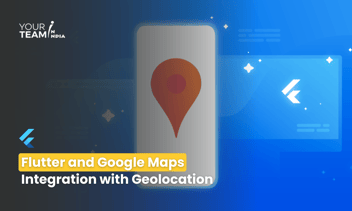Quick Summary: Embark on a journey into the realm of Natural Language Processing (NLP) in Flutter, as we explore the integration of TensorFlow. Uncover the power of language understanding and processing within your Flutter applications, opening new avenues for creating intelligent and responsive user interfaces.
Introduction
Natural Language Processing (NLP) has become an integral part of many modern applications, enabling them to understand, interpret, and generate human-like text. In the realm of mobile app development, Flutter has gained popularity for its cross-platform capabilities, allowing developers to build high-performance applications for both iOS and Android. When it comes to implementing NLP in Flutter, TensorFlow, an open-source machine learning framework, emerges as a powerful tool. In this article, we'll explore the integration of TensorFlow for NLP in Flutter.
Understanding Natural Language Processing (NLP)
NLP involves the interaction between computers and human languages. It enables machines to understand, interpret, and generate human-like text, allowing for more natural communication between humans and computers. NLP applications range from sentiment analysis and language translation to chatbots and virtual assistants.
TensorFlow: An Overview
TensorFlow, developed by the Google Brain team, is an open-source machine learning framework widely used for building various deep learning models. It provides a comprehensive ecosystem for developing machine learning applications, including support for NLP tasks.
Setting Up Flutter with TensorFlow
Before diving into NLP implementation, it's crucial to set up your Flutter project with TensorFlow. Flutter supports platform channels, which allow communication between Dart code and native code (in this case, TensorFlow's Python API). This enables you to leverage the power of TensorFlow within your Flutter application seamlessly.
To set up TensorFlow in Flutter, you can use the `tflite` package, which provides support for TensorFlow Lite. TensorFlow Lite is a lightweight version of TensorFlow designed for mobile and embedded devices.
Add the following dependencies to your `pubspec.yaml` file:
|
dependencies: tflite: ^2.0.0 tflite_flutter: ^0.5.0 |
Run `flutter pub get` to fetch the dependencies.
Loading a Pre-trained NLP Model
For NLP tasks, pre-trained models are often used due to the complexity and resource-intensive nature of training these models from scratch. TensorFlow provides various pre-trained models for NLP tasks, such as BERT (Bidirectional Encoder Representations from Transformers) for natural language understanding.
You can load a pre-trained TensorFlow Lite model using the `tflite_flutter` package. The following code snippet demonstrates how to load a model:
|
import 'package:tflite_flutter/tflite_flutter.dart'; void loadModel() async { String modelPath = 'assets/nlp_model.tflite'; await Tflite.loadModel( model: modelPath, labels: 'assets/labels.txt', ); } |
Make sure to replace `nlp_model.tflite` with the path to your pre-trained NLP model and `labels.txt` with the file containing the labels used by the model.
Performing NLP Inference
Once the model is loaded, you can perform NLP inference on input text. In this example, let's consider a simple sentiment analysis task:
|
String analyzeSentiment(String text) { List<List<double>> input = // Convert text to input format expected by the model var result = Tflite.runModelOnBinary( binary: input, ); // Process the result and return the sentiment // ... return sentiment; } |
The exact process for converting text to the input format expected by the model depends on the specific model architecture you're using. Refer to the documentation of the chosen pre-trained model for details.
Building a Flutter UI for NLP
Integrating NLP into your Flutter app wouldn't be complete without a user interface. You can design a simple UI to take user input and display the NLP analysis results.
|
import 'package:flutter/material.dart'; void main() { runApp(MyApp()); } class MyApp extends StatelessWidget { @override Widget build(BuildContext context) { return MaterialApp( home: Scaffold( appBar: AppBar( title: Text('NLP in Flutter'), ), body: NLPAnalysisScreen(), ), ); } } class NLPAnalysisScreen extends StatefulWidget { @override _NLPAnalysisScreenState createState() => _NLPAnalysisScreenState(); } class _NLPAnalysisScreenState extends State<NLPAnalysisScreen> { TextEditingController _textEditingController = TextEditingController(); String _sentimentResult = ''; @override Widget build(BuildContext context) { return Padding( padding: const EdgeInsets.all(16.0), child: Column( crossAxisAlignment: CrossAxisAlignment.stretch, children: [ TextField( controller: _textEditingController, decoration: InputDecoration(labelText: 'Enter Text'), ), SizedBox(height: 16), ElevatedButton( onPressed: () { String inputText = _textEditingController.text; String sentiment = analyzeSentiment(inputText); setState(() { _sentimentResult = sentiment; }); }, child: Text('Analyze Sentiment'), ), SizedBox(height: 16), Text( 'Sentiment: $_sentimentResult', style: TextStyle(fontSize: 18), ), ], ), ); } } |
This example provides a simple text input field, a button to trigger sentiment analysis, and a space to display the analysis result.
Conclusion
Integrating Natural Language Processing into Flutter using TensorFlow opens up a world of possibilities for creating intelligent and interactive applications. Whether it's sentiment analysis, language translation, or other NLP tasks, the combination of Flutter and TensorFlow empowers developers to build sophisticated cross-platform applications with ease. As the field of NLP continues to evolve, incorporating these technologies into your Flutter projects can enhance user experiences and make your applications more versatile and powerful.
Ready to elevate your Flutter app design? Unlock the full potential of Flutter layouts with our professional Flutter developers.








